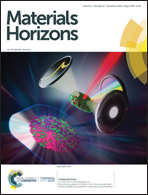Superionic conduction along ordered hydroxyl networks in molecular-thin nanosheets†
Abstract
Despite both hydronium and hydroxide ions exhibiting anomalously high mobilities in aqueous solutions, OH− conduction in solid electrolytes is considerably slower than that of H+, impeding a paradigm shift to many renewable energy and bioelectronic applications in an alkaline environment. Herein, we present that the mobility/diffusivity of hydroxide ions along a 2D ordered hydroxyl network can reach a level comparable to that of proton/hydroxide ion conduction in diluted acids/bases and some artificial or biomolecular proton conductors. Such a superionic conduction characteristic was quantified via direct measurements on individual single-layer nanosheets of layered double hydroxides (LDHs). A combined simulations study revealed that the superior hydroxide ion conduction was directly correlated with the hydroxyl network on an LDH sheet, which served as both a free hydroxide ion donor and 2D hopping lane in the presence of water. It was also revealed that the surface conduction was generally ∼1 order of magnitude faster than that along the gallery between nanosheets. This work provides insights into the origin and intrinsic mechanism of hydroxide ion conduction along ordered hydrogen-bonded nanostructures, which might inspire the creation of superionic functional materials in other systems.

- This article is part of the themed collection: Horizons Community Board Collection: Advanced Memory Technologies


 Please wait while we load your content...
Please wait while we load your content...